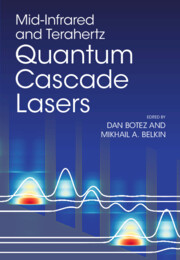Book contents
- Frontmatter
- Dedication
- Contents
- Preface
- Part I Bandstructure Engineering, Modeling and State-of-the-Art QCLs
- Part II Active Research Topics
- 7 Quantum Cascade Laser Frequency Combs
- 8 Frequency Noise and Frequency Stabilization of QCLs
- 9 Distributed-Feedback and Beam Shaping in Monolithic Terahertz QCLs
- 10 Metasurface-based THz Quantum Cascade Lasers
- 11 Terahertz Quantum Cascade Laser Sources Based on Intra-Cavity Difference-Frequency Generation
- Part III Applications
- Index
7 - Quantum Cascade Laser Frequency Combs
from Part II - Active Research Topics
Published online by Cambridge University Press: 25 August 2023
- Frontmatter
- Dedication
- Contents
- Preface
- Part I Bandstructure Engineering, Modeling and State-of-the-Art QCLs
- Part II Active Research Topics
- 7 Quantum Cascade Laser Frequency Combs
- 8 Frequency Noise and Frequency Stabilization of QCLs
- 9 Distributed-Feedback and Beam Shaping in Monolithic Terahertz QCLs
- 10 Metasurface-based THz Quantum Cascade Lasers
- 11 Terahertz Quantum Cascade Laser Sources Based on Intra-Cavity Difference-Frequency Generation
- Part III Applications
- Index
Summary
The advent of optical frequency combs revolutionized many research fields from metrology to high precision spectroscopy. It was recently demonstrated that broadband quantum cascade lasers can operate as frequency combs. As such, they operate under direct electrical pumping at both mid-infrared and terahertz frequencies, reaching powers in the watt range with multi-terahertz bandwidths. As their key application field, they unlock the advantages in speed and accuracy of the dual-comb spectroscopy technique in a frequency range where molecules have their fundamental vibrational and rotational bands. In this Chapter we review the design and basic functioning principles of these devices, the characterization of their coherence properties as well as few example applications.
- Type
- Chapter
- Information
- Mid-Infrared and Terahertz Quantum Cascade Lasers , pp. 203 - 248Publisher: Cambridge University PressPrint publication year: 2023

